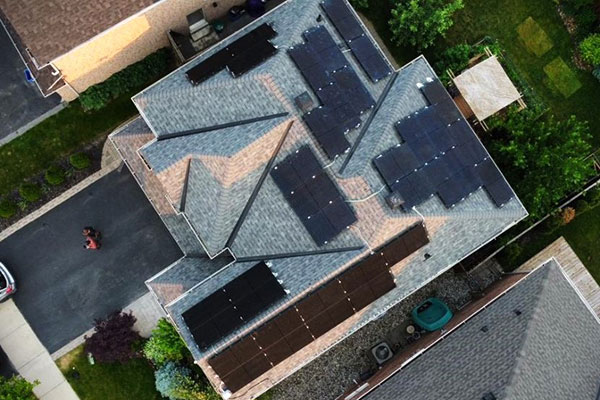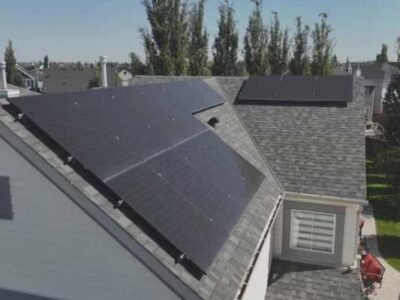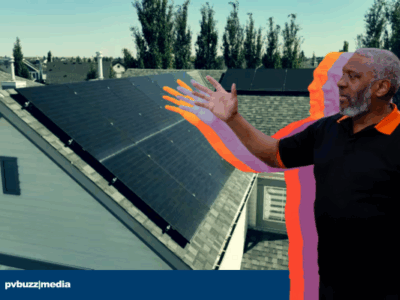- Ontario has some of Canada’s lowest solar installation costs, and rebates can shorten payback periods.
- Factors like roof orientation, shading, and electricity usage play a major role in determining savings.
- Net metering and local grid connection fees vary widely and impact return on investment.
When Heather McDiarmid first explored getting solar panels for her Ontario home, she hit an unexpected roadblock — her aging roof. Instead of risking future costs, she upgraded to metal shingles before installing a solar photovoltaic (PV) system.
“I didn’t want to have to tear everything out in a few years,” said McDiarmid, a climate change mitigation consultant based in Guelph. “Now it’s set for decades.”
As solar technology improves and prices drop, more Ontarians are weighing the costs and benefits of going solar. But experts caution: whether panels are a sound investment depends on more than just the sticker price.
A province-by-province payoff
The average solar installation in Canada costs around $3.34 per watt — about $25,000 for a 7.5-kilowatt system. Ontario homeowners benefit from some of the lowest prices in the country, at roughly $2.42 per watt.
That’s good news for residents like McDiarmid, who authored a 2023 report for the Ontario Clean Air Alliance. Her research found that a 10 kW system can save Ontarians about $1,584 per year on electricity bills, assuming time-of-use rates. With federal and provincial incentives — including a $5,000 Ontario rebate and an interest-free Greener Homes loan — that system might take 16 years to pay off, then keep generating savings for years to come.
“It’s not a short-term investment,” McDiarmid told CBC News. “But for many homeowners, especially those with higher energy use, it’s a practical way to control electricity costs.”
How solar savings stack up
Solar panels generate direct current electricity from sunlight, which an inverter converts for home use. Any excess power flows to the grid, earning credits via Ontario’s net metering program — effectively letting homeowners “bank” energy for later.
“Some folks generate surplus power all summer, then draw on those credits in the darker winter months,” said Joshua Pearce, a Western University professor who studies solar PV systems.
But performance depends heavily on your property. South-facing roofs tend to perform best, and trees or other obstructions can reduce output.
“I’m in the Forest City — London, Ont. — and even I’ve had to think hard about which trees to trim,” Pearce said. “Sometimes the biggest shade problem is your neighbour’s maple.”
Local climate and connection costs
Ontario falls in the middle of Canada’s solar spectrum. The Prairie provinces top the charts for sunlight hours, while coastal regions — including British Columbia and Newfoundland — tend to lag. These variations, combined with local utility policies, affect financial returns.
For example, in Ottawa, homeowners paid about $1,449 in 2023 to connect solar panels to the grid. In Sudbury, that cost was closer to $548.
And while Ontario’s $5,000 rebate is among the more generous provincial incentives, some areas — like Prince Edward Island — offer even more, though programs may be temporarily paused.
Is it worth it?
If your electricity costs are high — more than 12 cents per kilowatt-hour — solar is often a good bet, Pearce said. “That threshold makes a strong financial case.”
But not every household will benefit equally. Gas-heated homes use less electricity, while all-electric homes with heat pumps or electric vehicles may see faster payback.
For those considering solar, experts recommend checking annual electricity spending, getting multiple quotes, and assessing roof direction and shade. Adding battery storage can also improve resilience during outages.
“It’s about knowing your own home’s energy story,” McDiarmid said. “Then seeing if solar fits.”
Takeaway: In Ontario, falling solar costs, net metering, and new incentives make solar panels a compelling option — especially for high-usage households with sunny rooftops. But it’s not one-size-fits-all. Homeowners need to evaluate their electricity use, roof conditions, and local utility rules before deciding.












Comments